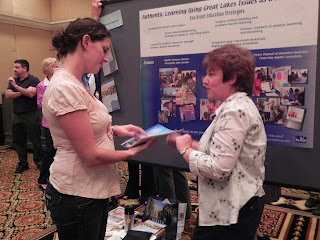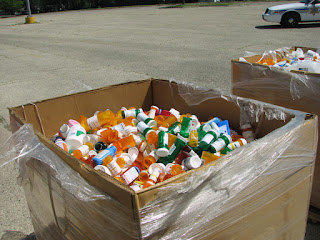February 11th, 2013 by Irene Miles
Today’s blog post features a fun bit of physics from Wired.com’s science blog.
Writer Rhett Allain, professor at Southeastern Louisiana University, received an interesting question over Twitter – “What would happen if everyone on the planet jumped in the water?”
He writes:
“Let’s give a slightly refined version of the question.
‘If everyone on Earth went for a swim at the same time in Lake Michigan, how high would the water level rise?’
I have two primary assumptions to start with. First, I will assume that during this time the volume of water in Lake Michigan will be constant. So if the people make the water level rise, the water level will indeed rise instead of pushing water into the other Great Lakes. Second, I will assume that all of the humans in the lake are floating. If they aren’t ‘swimming’ or touching the bottom, then it will be easier to calculate the rise in the water level.”
Follow the link above for a fun Lake Michigan physics lesson.
February 8th, 2013 by Irene Miles
The frigid waters of Lake Michigan during a Midwestern winter may not seem very inviting to us, but some species spend a great deal of time there.
From Phys.org:
“On Nov. 2, 2010, Mueller documented 25,555 long-tailed ducks in Lake Michigan.
And on Jan. 20, 2011, 9,311 red-breasted mergansers were tallied.
 The data comes from the Lake Michigan Offshore Waterfowl and Waterbird Survey, a project initiated in 2009 by Mueller and Noel Cutright, both of the Western Great Lakes Bird and Bat Observatory in Belgium.
The data comes from the Lake Michigan Offshore Waterfowl and Waterbird Survey, a project initiated in 2009 by Mueller and Noel Cutright, both of the Western Great Lakes Bird and Bat Observatory in Belgium.
The work is designed to increase the understanding of key offshore Lake Michigan bird habitats, many of which have been lightly studied.”
Read more at the link above, including details about how the data they collect can help not only understand the presence and habitats of animals, but can guide safer development of energy production on the Great Lakes too.
February 7th, 2013 by Irene Miles
IISG’s Aquaculture Marketing Specialist Kwamena Quagrainie, who also directs the aquaculture economics and marketing program at Purdue University, was recently promoted to the position of Clinical Engagement Assistant Professor in Agricultural Economics. Dr. Quagrainie has been involved for many years in aquaculture marketing and outreach, helping numerous aquaculture operations get started or expand their business throughout the Midwest. He has also been involved in international efforts to promote and foster aquaculture operations throughout several African nations.
The Clinical Engagement professorship emphasizes transfer of applied research results to aquaculture communities small and large. The goal of this position is to promote active engagement in a field, which is the type of work that Dr. Quagrainie has been directly involved in for many years now. This promotion will give him even more opportunities to bring his expertise to aquaculture producers–helping businesses and communities grow.
February 5th, 2013 by Irene Miles
Illinois-Indiana Sea Grant is celebrating its 30th anniversary, and 30 years of working to protect and preserve the beauty and resources of Lake Michigan. But what is some of that work? What are some of the things that IISG does to understand, restore, and celebrate our Great Lakes resources?
We’re glad you asked. Our latest publication features 30 milestone achievements selected from the last three decades, all detailing ways that we support our mission to improve and protect the southern Lake Michigan area.
Visit the link to download your own copy of our 30 milestones, or contact us if you would like print copies to share with. And here’s to the next 30 years of keeping our Great Lakes great!
February 4th, 2013 by Irene Miles
 SeaPerch, a program that brings underwater robotics to classrooms and demonstrates how they can be used for educational purposes, recently held a workshop at the University of Illinois Hydrosystems Laboratory. IISG’s Robin Goettel and Terri Hallesy were among the presenters and they shared a number of educational materials that teachers could combine with their classes’ underwater robots.
SeaPerch, a program that brings underwater robotics to classrooms and demonstrates how they can be used for educational purposes, recently held a workshop at the University of Illinois Hydrosystems Laboratory. IISG’s Robin Goettel and Terri Hallesy were among the presenters and they shared a number of educational materials that teachers could combine with their classes’ underwater robots.
Thirteen Champaign-Urbana science teachers were in attendance to learn how to incorporate SeaPerch underwater robots into their classroom curricula. Coordinators from Naval Sea Systems Command – Crane STEM led the morning session to introduce the SeaPerch program, provide helpful tips for constructing the complimentary robot kit each teacher received, and discuss relevant resources for classroom use. Additional robots commonly deployed for scientific applications were also highlighted.
 Over lunch, participants interacted with U of I graduate students in engineering to discuss research topics and applications for their in-class lessons. Robin and Terri shared educational resources including two COSEE Great Lakes curriculum collections, Greatest of the Great Lakes: A Medley of Model Lessons, and a Fresh and Salt activity, “I, Robot, Can Do That!”
Over lunch, participants interacted with U of I graduate students in engineering to discuss research topics and applications for their in-class lessons. Robin and Terri shared educational resources including two COSEE Great Lakes curriculum collections, Greatest of the Great Lakes: A Medley of Model Lessons, and a Fresh and Salt activity, “I, Robot, Can Do That!”
During the afternoon session, a live demonstration of the SeaPerch robot was conducted and teachers had an opportunity to operate the SeaPerch robots in the large-scale laboratory facilities.
SeaPerch is a joint program of the Office of Naval Research and the AUVSI Foundation. Visit the SeaPerch homepage to learn more about bringing underwater robotics to the classroom, and for a calendar of upcoming workshops and events.
February 1st, 2013 by Irene Miles
 The Paul A. Funk Recognition Award provides a personal award to the winner as well as funds for their department to use in support of their work benefiting natural resources and human environmental systems.
The Paul A. Funk Recognition Award provides a personal award to the winner as well as funds for their department to use in support of their work benefiting natural resources and human environmental systems.
This year, Illinois-Indiana Sea Grant’s Robin Goettel won the award for her extensive educational outreach work, including the creation of numerous curricula for science teachers and others. In particular, the Fresh and Salt curriculum, the Greatest of the Great Lakes collection of model lessons, and The Medicine Chest have helped to inform, engage, and education over 100,000 students about environmental science related to the Great Lakes.
Robin isn’t afraid to get totally immersed in her environmental education work either, as this excerpt from her nomination proves:
“No description of Robin would be complete without a mention of Zelda the zebra mussel, a ‘spokesmussel,’ as Robin describes her. Zelda is a costume that Robin is not afraid to pull out at public events. While maybe not quite ready for Disneyworld, Zelda draws a crowd. People start with a laugh, are compelled to ask questions, and end up with a better understanding of invasive species for the unconventional approach.”
Those examples don’t begin to touch on the work that Robin has engaged in throughout her many years with the program–from direct engagement with students of all grade levels, to educational displays at some of the Midwest’s biggest events, to forging partnerships with other environmental organizations to better educate, inform, and engage people in protecting and preserving natural resources.

Robin’s many years of work on environmental issues, and her dedication to fostering ever higher levels of science education for students of all ages, make her a terrific and very deserving choice for this award.
January 30th, 2013 by Irene Miles
One of the most important planning concerns in the coming years will be ensuring the smart, sensible use and long-term availability of water resources for a growing population. This is especially true in large urban areas like Chicago, which has adopted the GO TO 2040 comprehensive regional plan to address and prepare for future growth.
 Since both Water2050 and the long-range GO TO 2040 comprehensive plan recommend full-cost pricing for drinking water to promote water conservation and address aging infrastructure, the Full-Cost Water Pricing Guidebook is designed for local decision makers interested in exploring full-cost pricing as a tool for sustainable community water supply management. The first section provides mayors, village managers, planners, board and council members, and interested residents with the reasons why such planning is important. The second section offers a basic ‘how to do it’ overview for readers interested in learning more, and the third section explores one of the most important decisions in setting water rates, designing the rate structure. Margaret has also developed a downloadable Powerpoint presentation providing an overview of full-cost pricing, available at the guidebook link above.
Since both Water2050 and the long-range GO TO 2040 comprehensive plan recommend full-cost pricing for drinking water to promote water conservation and address aging infrastructure, the Full-Cost Water Pricing Guidebook is designed for local decision makers interested in exploring full-cost pricing as a tool for sustainable community water supply management. The first section provides mayors, village managers, planners, board and council members, and interested residents with the reasons why such planning is important. The second section offers a basic ‘how to do it’ overview for readers interested in learning more, and the third section explores one of the most important decisions in setting water rates, designing the rate structure. Margaret has also developed a downloadable Powerpoint presentation providing an overview of full-cost pricing, available at the guidebook link above.
For further information about water supply issues and planning, visit our water supply page on the website, and you can contact Margaret directly for additional information and print copies of the guidebook.
January 29th, 2013 by Irene Miles
 The Drug Enforcement Administration has published proposed regulations regarding the proper disposal of prescription pharmaceuticals and other controlled substances.
The Drug Enforcement Administration has published proposed regulations regarding the proper disposal of prescription pharmaceuticals and other controlled substances.
From the DEA’s release:
“This rule proposes requirements to govern the secure disposal of controlled substance medications by both DEA registrants and what the Controlled Substances Act refers to as “ultimate users” of these medications (patients and animals). The proposed regulations seek to expand the options available to collect these medications from ultimate users for the purpose of disposal, to include take-back events, mail-back programs, and collection box locations.”
The public comment period is open until February 19, and people can review the entire proposal online here.
For more information about why proper disposal of these substances is so important, visit our Unwanted Meds website.
January 25th, 2013 by Irene Miles
The Chicago Metropolitan Agency for Planning (CMAP) was recently recognized with a National Planning Excellence award for their work developing GO TO 2040 – a comprehensive regional plan that unites and coordinates seven counties infrastructure development.
Illinois-Indiana Sea Grant’s Margaret Schneeman, who works directly with CMAP, was involved in the plan development and implementation, and Martin Jaffe served on the Regional Water Supply planning group. Their efforts, combined with the expertise and work of dozens of individuals and agencies, resulted in the completion of the regional plan that will enhance sustainable development and planning throughout 284 communities in and around the Chicago area.
The summarized plan can be read here, and you can visit the GO TO 2040 link above to read the complete plan.
The American Planning Association awards programs, individuals, and agencies that utilize and implement planning techniques designed to create more sustainable communities. Visit the National Planning Awards 2013 webpage to see the complete list of award winners, including information about the GO TO 2040 plan.
You can also visit our Water Supply page to learn more about the importance of planning on water quality, safety, and availability.









